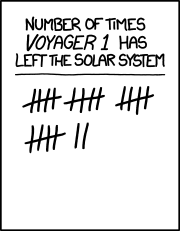Tag archives: social media
Sporty physics, the pub in a Faraday cage, LEGO NASA women and more
By Michael Banks and Tushna Commissariat
The Rio 2016 Olympics will kick off tomorrow and over the next three weeks, while you enjoy watching the world’s top athletes compete in the huge variety of sports, spare a thought for the physics involved. From how to throw a ball to running, from pole vaulting to golf, physics and sport are fellow brethren. Head on over on the JPhys+ blog to read “The big physics of sport round-up!” post and watch our video series above, in between cheering on your favourite teams.
View all posts by this author | View this author's profile
Uncovering the truth in social media

Truth and lies in the web of social media. (Courtesy: Shutterstock)
By James Dacey
“On 27 August…Mars will look as large as the full Moon.”
This was a sentence from a widely circulated e-mail in 2005, in the lead up to one of the closest encounters between Earth and Mars in recorded history.
That our neighbouring planet could appear as prominent as the Moon is, of course, complete claptrap. Since the “Mars hoax” first appeared in 2003, it has re-emerged several times over the past decade.
The Mars hoax is an example of a “meme”, a piece of content or an idea that is spread virally across Internet networks. These days, memes such as this can spread with increasing speed and reach, thanks to the ever-growing expansion of social-media sites such as Facebook and Twitter.
Now, however, researchers at MODUL University Vienna are setting out on the ambitious task of assessing the truthfulness of information that goes viral on social-media sites. The folks behind the project, called PHEME, say that one of their major aims is to acquire an improved understanding of the types of dubious information that are most likely to spread across networks.
View all posts by this author | View this author's profile
In pictures: the opinions of Physics World readers
By James Dacey
Love it, or love to hate it, one thing that social media has undoubtedly achieved is to break down some of the barriers between professional journalists and their readers. Gone are the days when we had to rely almost exclusively on guesswork and intuition when it came to picking the issues that matter the most to our readers. Of course, we have always received “proper” letters in the days and weeks following the publication of Physics World to inform us when readers were pleased (or slightly less approving!) of the words they had read. But these days, the feedback starts pouring in almost as soon as our online articles are published, courtesy of our 170,000 Facebook fans and 50,000 Twitter followers. If our readers’ hackles are raised by certain articles and issues, then believe me – we know about it very quickly.
View all posts by this author | View this author's profile
NASA asked, so we waved at Saturn
By James Dacey

Wave at Saturn collage. (Courtesy: NASA/JPL-Caltech)
On 19 July the Cassini spacecraft turned back to face Earth from its location by Saturn and captured this humbling photo of our planet as a tiny dot behind Saturn’s rings. As part of the event, NASA encouraged people to snap pictures of themselves waving at Venus and to share these via social-media sites. Now, 1400 of these images have been used to create this collage, which includes people from more than 40 countries and 30 US states.
“While Earth is too small in the images Cassini obtained to distinguish any individual human beings, the mission has put together this collage so that we can celebrate all your waving hands, uplifted paws, smiling faces and artwork,” says Linda Spilker, Cassini project scientist at NASA’s Jet Propulsion Laboratory in California.
NASA has, however, released a larger version of the “Wave at Saturn” collage where you can zoom in to make out individual images. It is well worth doing so, as you quickly come across the whole spectrum of gestures from the gentle wave to the Vulcan salute.
View all posts by this author | View this author's profile
Should scientists speculate openly in the mainstream media about new science results?
By James Dacey

Read all about it! (Courtesy: iStockphoto/DNY59)
The first science results from the Alpha Magnetic Spectrometer (AMS) present a mixed bag for both scientists and journalists. On the one hand, they show that the machinery of this high-profile $1.5bn mission is actually working. And as my colleague Michael Banks reported earlier today, the excess of positrons, confirming previous measurements, represent an important step in the hunt for dark matter. But on the other hand, this was not a moment to break out the champagne at the celebration of new physics. In reality, it was an important step in testing the precision of the instrument, as well as a reminder that we all need to be patient while we wait for more data.
Given the scale and scope of the AMS mission, it is not surprising that the scientists involved in analysing these first results are keen to share their excitement with the general public. One way they have been doing this is by talking to the media and speculating about the significance of the findings. I find it really interesting to look at how the results have been covered in the headlines of the mainstream media. The BBC ran with “Alpha Magnetic Spectrometer zeroes in on dark matter”. Over the pond, the New York Times went for “Tantalizing New Clues Into the Mysteries of Dark Matter”, adopting the classic science-writing metaphor of a detective story. Both parties presented these early results as an exciting development in a gripping plot to uncover one of the long-standing mysteries of the cosmos.
Voyager 1, where art thou?
By Tushna Commissariat
It’s a running joke at the Physics World news desk – the exact location of the Voyager 1 probe and how often we end up writing about how it really has nearly left the solar system this time. So we decided to wait and watch when the news broke on Wednesday evening this week that the probe had left the solar system for sure (again).
Unsurprisingly, the next morning our inboxes included a slightly sheepish “status update” message from NASA. “The Voyager team is aware of reports today that NASA’s Voyager 1 has left the solar system,” says Edward Stone, Voyager project scientist based at the California Institute of Technology, Pasadena. “It is the consensus of the Voyager science team that Voyager 1 has not yet left the solar system or reached interstellar space. In December 2012 the Voyager science team reported that Voyager 1 is within a new region called ‘the magnetic highway’ where energetic particles changed dramatically. A change in the direction of the magnetic field is the last critical indicator of reaching interstellar space, and that change of direction has not yet been observed.”
Teaching an old blog new tricks
By Hamish Johnston

(iStockphoto/webphotographeer)
When the Physics World editorial team started blogging in earnest early in 2008, it was our first chance to interact much more directly and informally with the physics community – prior to that we had been mainly restricted to conventional news stories and features. Since then, of course, the social-media world has grown out of all recognition and Physics World is now on Twitter, Facebook, Flickr, Google+ and YouTube, with these sites giving us new ways of communicating with you (and vice versa).
But we think the Physics World blog still has a big role to play in what we do and today marks a major upgrade to it. While most of the improvements are behind the scenes, I thought I’d mention a few new features we hope you’ll enjoy.
View all posts by this author | View this author's profile
